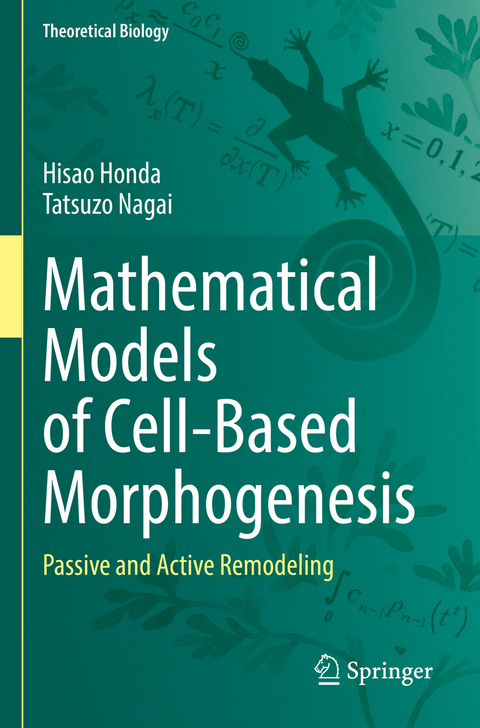
Mathematical Models of Cell-Based Morphogenesis
Springer Verlag, Singapore
978-981-19-2918-2 (ISBN)
The book introduces two mathematical cell models, the cell center model and the vertex model, with their applications. The cell center model is applied to elucidate the formation of neat cell arrangements in epidermis, cell patterns consisting of heterogeneous-sized cells, capillary networks, and the branching patterns of blood vessels. The vertex model is applied to elucidate the wound healing mechanisms of the epithelium and ordered pattern formation involving apoptosis. Pattern formation with differential cell adhesion is also described. The vertex model is then extended from a two-dimensional (2D) to a three-dimensional (3D) model. A cell aggregate involving a large cavity is described to explain the development of the mammalian blastocyst or the formation of an epithelial vesicle. Epithelial tissues and the polarity formation process of the epithelium are also explained. The vertex model also recapitulates active remodeling of tissues and describes the twisting of tissue that contributes to understanding the cardiac loop formation of the embryonic tube. The book showcases that mathematical cell models are indispensable tools to understand the shape formation of living organisms. Successful contribution of the mathematical cell models means that the remodeling of collective cells is self-construction. Examining the successive iterations of self-constructions leads to understanding the remarkable and mysterious morphogenesis that occurs during the development of living organisms.
The intended readers of this book are not only theoretical or mathematical biologists, but also experimental and general biologists, including undergraduate and postgraduate students who are interested in the relationship between genes and morphogenesis.Hisao Honda has been a Guest Professor at the Graduate School of Medicine, Kobe University, Japan since 2012. He is an Emeritus Professor of Hyogo University, Kakogawa, Japan. His research interests include theoretical biology, especially morphogenesis of multicellular organisms and branching structures. He received his PhD from Kyoto University in 1973. He worked as a Researcher, Senior Researcher and Chief Researcher at Kanebo Institute for Cancer Research, Kobe and Osaka (1975-1996) and a Professor at Hyogo University (1996-2013), prior to joining the Graduate School of Medicine, Kobe University. Tatsuzo Nagai had been a Professor at Kyushu Kyoritsu University, Kitakyushu, Japan between 1981 and 2008. He has been an Emeritus Professor at Kyushu Kyoritsu University since 2009. His research interests include statistical physics, especially dynamical interfacial systems, i.e., soap froths, grain aggregates and biological cell aggregates. He received his PhD from Kyushu University, Fukuoka, Japan in 1972. He worked as an associate Professor at Kyushu Kyoritsu University from 1973, prior to being a Professor.
Chapter 1. Introduction.- Chapter 2.Cell center model.- Chapter 3.Applications of the cell center model.- Chapter 4. Vertex mode.- Chapter 5.Applications of the cell models to 2D cell patterns.- Chapter 6.3D vertex model.- Chapter 7.The world of epithelial sheets[7·1].- Chapter 8.Cells themselves produce force for active remodeling.- Chapter 9.Expansion of shape-dimension.- Chapter 10.Mathematical cell models and morphogenesis.
| Erscheinungsdatum | 30.06.2023 |
|---|---|
| Reihe/Serie | Theoretical Biology |
| Zusatzinfo | 1 Illustrations, black and white; VIII, 192 p. 1 illus. |
| Verlagsort | Singapore |
| Sprache | englisch |
| Maße | 155 x 235 mm |
| Themenwelt | Informatik ► Weitere Themen ► Bioinformatik |
| Mathematik / Informatik ► Mathematik ► Angewandte Mathematik | |
| Naturwissenschaften ► Biologie ► Allgemeines / Lexika | |
| Naturwissenschaften ► Biologie ► Mikrobiologie / Immunologie | |
| Naturwissenschaften ► Biologie ► Zellbiologie | |
| Naturwissenschaften ► Physik / Astronomie ► Angewandte Physik | |
| Schlagworte | Cell sorting • epithelium • mathematical cell models • Morphogenesis • Remodeling • shape of organ • signal pathway • vertex cell dynamics |
| ISBN-10 | 981-19-2918-1 / 9811929181 |
| ISBN-13 | 978-981-19-2918-2 / 9789811929182 |
| Zustand | Neuware |
| Informationen gemäß Produktsicherheitsverordnung (GPSR) | |
| Haben Sie eine Frage zum Produkt? |
aus dem Bereich


